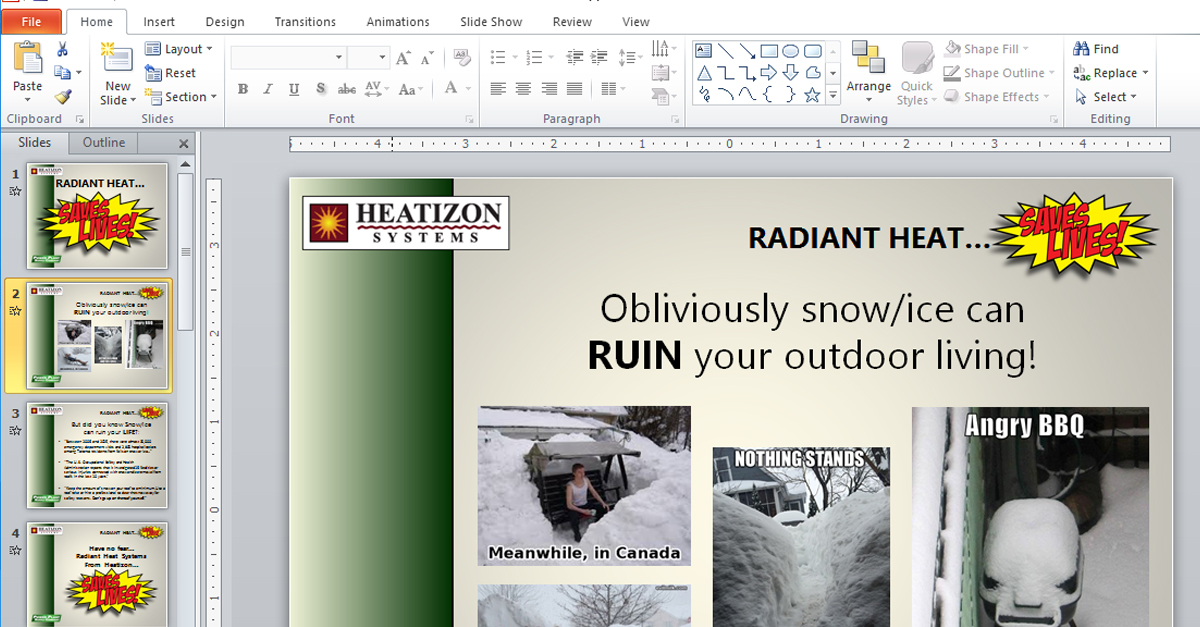ZMesh Radiant Heat
May 12, 2006
By Steven D. Bench
Managing Member
Heatizon Systems
When people associated with the radiant heating and radiant snow melting industry use the words “ZMesh”, “Golden Mesh”, “Z Mesh”, or just plain “Mesh” usually they are referring to a durable line of low voltage electric products made by Heatizon Systems and used for Radiant Roof Snow Melt and De-icing, Radiant Floor Warming and Radiant Heating.
Designed to be installed on and under sub-floors and on sub-roofs, ZMesh provides a nice uniform heat and it is plenty robust to satisfy the demands of discriminating radiant heat, radiant roof snow melting and de-icing, and radiant floor warming customers. In addition, gold colored, ZMesh delivers unparallel performance and is backed by an industry leading twenty-five (25) year warranty.
What about the nails, screws, and/or staples used to attach certain flooring and roofing materials? No need to worry about nailing, screwing or stapling through ZMesh as long as the nail, screw, or staple does not come into contact with anything else electronically conductive. In other words, ZMesh should never be installed over or under metal roof decking, valley metal, metal flashing, etc. or metal roofing materials such as steel or copper but its durable sister Tuff Cable may be installed over and under such products. ZMesh can be installed, however, under all non-conductive roof shingles and nearly all floor coverings.
Unlike its line voltage and hydronic radiant heating, radiant in-floor and under floor warming and radiant roof snow melt and de-icing competitors, ZMesh is very simple and easy to repair in the event it gets cut or damaged. Repairing ZMesh requires a customized copper splice plate and a bit of solider. No one else in the radiant heating, radiant floor warming and radiant roof snow melt and de-icing business can honestly make that claim.
How much floor build-up does ZMesh require? Since ZMesh is only 1/16th of an inch thick and does not require a bed of light weight concrete or other cementous material to draw the heat away from it the answer to this question is “very little”! As a result using ZMesh avoids the expense of a cementious mud bed, the cost of the extra structural integrity necessary to support the weight of the concrete and the challenges created by the need for the additional framing required by radiant high or line voltage and radiant hydronic or hot water alternatives. Once again, ZMesh requires little or no floor build-up.
For radiant in-floor and under floor warming and radiant heating applications ZMesh may be installed in the floor (on top of the sub-floor and below the floor covering) or under the floor between the joist space. As a matter of fact, Heatizon Systems was one of the pioneers of retrofitting its products into the joist space of existing structures.
ZMesh is a cut to length in the field product rather than a fixed length product like most all of its UL listed radiant line or high voltage competitors. The ability to vary the length of the ZMesh enables the installer to adjust the radiant in-floor heating, radiant roof snow melt and de-icing or radiant floor warming system to fit the area rather than requiring that the area to adjust to the radiant in-floor heating, radiant roof snow melting and de-icing or floor warming system.
Available in lengths that extend from 50 feet to 400 feet and widths of 9 and 12 inches, ZMesh is plenty versatile to satisfy the needs of most projects. In addition ZMesh has the ability to deliver up to 11.5 watts or over 39 Btu’s per linear foot so it is plenty robust to heat entire spaces, warm spacious floors, and manage the risks of ice dam related roof damage.
Heatizon Systems cares about its customers and their property as a result all of its products have been tested to UL Standards and has earned the privledge of being listed by ETL, an internationally recognized testing laboratory approved by the United States Environmental Protection Agency.
Heatizon Systems products are proudly manufactured in the United States of America and may be purchased by fine distributors located across North America.
